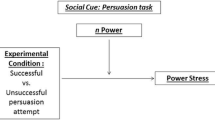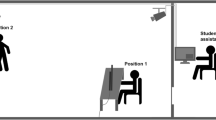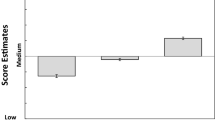Abstract
In this paper, we examine the relationship between the implicit power motive (nPow) and power stress in primary school children under the additional consideration of moderating effects of the implicit affiliation–intimacy motive (nAff–Int), activity inhibition (AI), and trait extraversion/surgency. The attitude towards a bossy non-player character (NPC) in a video game was used as an indicator of power stress. Eighty-four German children (39 female) in the age of 6 through 7 years (M = 6.83, SD = 0.44) participated. As hypothesized, children high in nPow reported a less favorable attitude towards the bossy NPC. Furthermore, we found significant interactions of nPow with both nAff–Int and trait extraversion/surgency: Children high in nPow particularly reported a less favorable attitude towards the bossy NPC if they were also low in nAff–Int or high in extraversion/surgency. In contrast to our hypotheses, we found no significant interaction of nPow and AI. The implications of these results for implicit motive theory and power stress research in children are discussed.



Similar content being viewed by others
Notes
An interesting aside is that none of the behavioral data was significantly associated with nPow, even in a regression analysis with ability to handle the controller as a covariate (N = 94, admonitions p = .29, ß = − .11; teleportations p = .25, ß = − .12; game duration p = .56, ß = − .06). These findings will be addressed again in the discussion.
In a rerun of the analyses, we included all 16 children that were excluded based on missing ratings of their ability to handle the game controller by assigning them the sample mean value on this variable (sample mean = 2.99; N = 100). As a result of this tentative approach, the main effect of nPow in the first model (p = .07, ß = − .18) and the interaction effect of nPow and extraversion/surgency in the third model (p = .07, ß = − .18) became insignificant. However, Bing et al. (2007) emphasize that so-called marginally significant interaction effects between implicit and explicit personality components also make a valuable contribution to the development of a more comprehensive framework of personality. All other findings did not change substantially.
nPow significantly correlated with age (r = .22, p = .04). Hence, we reran all analyses with nPow controlled for age. This did not substantially change findings reported in text. Moreover, age did not correlate with the attitude towards the NPC, thus we did not include it as an additional covariate.
An exploratory analysis of the three-way interaction of nPow, nAff–Int, and extraversion/surgency, F(12, 71) = 3.02, p < .01, showed that it was not a significant predictor (p = .08, ß = .22) of the attitude towards the NPC.
References
Bagdi, A., & Pfister, I. K. (2006). Childhood stressors and coping actions: A comparison of children and parents’ perspectives. Child & Youth Care Forum,35, 21–40. https://doi.org/10.1007/s10566-005-9001-8.
Bing, M. N., LeBreton, J. M., Davison, H. K., Migetz, D. Z., & James, L. R. (2007). Integrating implicit and explicit social cognitions for enhanced personality assessment: A general framework for choosing measurement and statistical methods. Organizational Research Methods,10, 136–179. https://doi.org/10.1177/1094428106289396.
Bradley, M. M., & Lang, P. J. (1994). Measuring emotion: The self-assessment manikin and the semantic differential. Journal of Behavior Therapy and Experimental Psychiatry,25, 49–59. https://doi.org/10.1016/0005-7916(94)90063-9.
Busch, H. (2018). Power motivation. In J. Heckhausen & H. Heckhausen (Eds.), Motivation and action (3rd ed., pp. 335–368). Cham, Switzerland: Springer. https://doi.org/10.1007/978-3-319-65094-4_8.
Clahsen, H. (1983). Some more remarks on the acquisition of German negation. Journal of Child Language,10, 465–469. https://doi.org/10.1017/S030500900007911.
Cook, R. D., & Weisberg, S. (1982). Residuals and influence in regression. New York, NY: Chapman and Hall.
Cumming, G. (2014). The new statistics: Why and how. Psychological Science,25, 7–29. https://doi.org/10.1177/0956797613504966.
Davies, J., & Brember, I. (1994). The reliability and validity of the ‘smiley’ scale. British Educational Research Journal,20, 447–454. https://doi.org/10.1080/0141192940200406.
Fodor, E. M. (1984). The power motive and reactivity to power stresses. Journal of Personality and Social Psychology,47, 853–859. https://doi.org/10.1037/0022-3514.47.4.853.
Fodor, E. M. (2010). Power motivation. In O. C. Schultheiss & J. C. Brunstein (Eds.), Implicit motives (pp. 3–29). New York, NY: Oxford University Press.
Fodor, E. M., & Wick, D. P. (2009). Need for power and affective response to negative audience reaction to an extemporaneous speech. Journal of Research in Personality,43, 721–726. https://doi.org/10.1016/j.jrp.2009.06.007.
Fodor, E. M., Wick, D. P., & Hartsen, K. M. (2006). The power motive and affective response to assertiveness. Journal of Research in Personality,40, 598–610. https://doi.org/10.1016/j.jrp.2005.06.001.
Fritz, G., Spirito, A., Yeung, A., Klein, R., & Freedman, E. (1994). A pictorial visual analog scale for rating severity of childhood asthma episodes. Journal of Asthma,31, 473–478. https://doi.org/10.3109/02770909409089489.
Goldberg, L. R. (1990). An alternative “description of personality”: The big-five factor structure. Journal of Personality and Social Psychology,59, 1216–1229. https://doi.org/10.1037/0022-3514.59.6.1216.
Hofer, J., Busch, H., & Schneider, C. (2015). The effect of motive-trait interaction on satisfaction of the implicit need for affiliation among German and Cameroonian adults. Journal of Personality,83, 167–178. https://doi.org/10.1111/jopy.12092.
Hofer, J., & Hagemeyer, B. (2018). Social bonding: Affiliation motivation and intimacy motivation. In H. Heckhausen & J. Heckhausen (Eds.), Motivation and action (3rd ed., pp. 305–334). Cham, Switzerland: Springer. https://doi.org/10.1007/978-3-319-65094-4_8.
Jemmott, J. B., & McClelland D. G. (1989). Secretory IgA as a measure of resistance to infectious disease: Comments on Stone, Cox, Valdimarsdottir, and Neale. Behavioral Medicine, 15, 63–71. https://doi.org/10.1080/08964289.1989.9935153.
Karmiloff-Smith, A. (1992). Beyond modularity: A developmental approach to cognitive science. Cambridge, MA: MIT Press.
Koo, T. K., & Li, M. Y. (2016). A guideline of selecting and reporting intraclass correlation coefficients for reliability research. Journal of Chiropractic Medicine,15, 155–163. https://doi.org/10.1016/j.jcm.2016.02.012.
Lang, J. W., Zettler, I., Ewen, C., & Hülsheger, U. R. (2012). Implicit motives, explicit traits, and task and contextual performance at work. Journal of Applied Psychology,97, 1201–1217. https://doi.org/10.1037/a0029556.
Langens, T. A. (2010). Activity inhibition. In O. C. Schultheiss & J. C. Brunstein (Eds.), Implicit motives (pp. 89–115). New York, NY: Oxford University Press.
Langner, C. A., & Winter, D. G. (2001). The motivational basis of concessions and compromise: Archival and laboratory studies. Journal of Personality and Social Psychology,81, 711–727. https://doi.org/10.1037/0022-3514.81.4.711.
Layous, K., Nelson, S. K., Oberle, E., Schonert-Reichl, K. A., & Lyubomirsky, S. (2012). Kindness counts: Prompting prosocial behavior in preadolescents boosts peer acceptance and well-being. PLoS ONE,7, e51380. https://doi.org/10.1371/journal.pone.0051380.
Leander, N. P., & Chartrand, T. L. (2017). On thwarted goals and displaced aggression: A compensatory competence model. Journal of Experimental Social Psychology,72, 88–100. https://doi.org/10.1016/j.jesp.2017.04.010.
McClelland, D. C. (1975). Power: The inner experience. New York, NY: Irvington.
McClelland, D. C. (1976). Sources of stress in the drive for power. In G. Serban (Ed.), Psychopathology of human adaptation (pp. 247–270). New York, NY: Plenum Press.
McClelland, D. C. (1989). Motivational factors in health and disease. American Psychologist,44, 675–683. https://doi.org/10.1037/0003-066X.44.4.675.
McClelland, D. C., Alexander, C., & Marks, E. (1982). The need for power, stress, immune function, and illness among male prisoners. Journal of Abnormal Psychology,91, 61–70. https://doi.org/10.1037/0021-843X.91.1.61.
McClelland, D. C., Davis, W. N., Kalin, R., & Wanner, E. (1972). The drinking man: Alcohol and human motivation. New York, NY: Free Press.
McClelland, D. C., & Jemmott, J. B., III. (1980). Power motivation, stress and physical illness. Journal of Human Stress,6, 6–15. https://doi.org/10.1080/0097840X.1980.9936101.
McClelland, D. C., Koestner, R., & Weinberger, J. (1989). How do self-attributed and implicit motives differ? Psychological Review,96, 690–702. https://doi.org/10.1037/0033-295X.96.4.690.
Miller, G. E., Chen, E., & Parker, K. J. (2011). Psychological stress in childhood and susceptibility to the chronic diseases of aging: Moving toward a model of behavioral and biological mechanisms. Psychological Bulletin,137, 959–997. https://doi.org/10.1037/a0024768.
O’Connor, B. P. (1998). SIMPLE: All-in-one programs for exploring interactions in moderated multiple regression. Educational and Psychological Measurement,58, 833–837. https://doi.org/10.1177/0013164498058005009.
Patrician, P. A. (2004). Single-item graphic representational scales. Nursing Research,53, 347–352. https://doi.org/10.1097/00006199-200409000-00011.
Phinney, J. S. (1986). The structure of 5-year-olds’ verbal quarrels with peers and siblings. The Journal of Genetic Psychology,147, 47–60. https://doi.org/10.1080/00221325.1986.9914479.
Putnam, S. P., & Rothbart, M. K. (2006). Development of short and very short forms of the children’s behavior questionnaire. Journal of Personality Assessment,87, 102–112. https://doi.org/10.1207/s15327752jpa8701_09.
Raihala, C., & Hansen, G. (2019). Power stress in primary school children. Motivation and Emotion,43, 82–92. https://doi.org/10.1007/s11031-018-9724-0.
Raihala, C., & Kranz, D. (2019). Choose it or lose it: The implicit power motive in children and their resource control behavior. Motivation Science,5, 86–91. https://doi.org/10.1037/mot0000093.
Rigby, K. (2005). Why do some children bully at school? The contributions of negative attitudes towards victims and the perceived expectations of friends, parents and teachers. School Psychology International,26, 147–161. https://doi.org/10.1177/0143034305052910.
Rösch, A. G., Stanton, S. J., & Schultheiss, O. C. (2013). Implicit motives predict affective responses to emotional expressions. Frontiers in Psychology,4, 985. https://doi.org/10.3389/fpsyg.2013.00985.
Schultheiss, O. C., & Brunstein, J. C. (2001). Assessment of implicit motives with a research version of the TAT: Picture profiles, gender differences, and relations to other personality measures. Journal of Personality Assessment,77, 71–86. https://doi.org/10.1207/S15327752JPA7701_05.
Schultheiss, O. C., & Pang, J. S. (2007). Measuring implicit motives. In R. W. Robins, R. C. Fraley, & R. F. Krueger (Eds.), Handbook of research methods in personality psychology (pp. 322–344). New York, NY: Guilford Press.
Schultheiss, O. C., Riebel, K., & Jones, N. M. (2009). Activity inhibition: A predictor of lateralized brain function during stress? Neuropsychology,23, 392–404. https://doi.org/10.1037/a0014591.
Smith, C. P., Feld, S. C., & Franz, C. E. (1992). Methodological considerations: Steps in research employing content analysis systems. In C. P. Smith (Ed.), Motivation and personality: Handbook of thematic content analysis (pp. 515–536). New York, NY: Cambridge University Press. https://doi.org/10.1017/CBO9780511527937.038.
Smith, M., Hubbard, J. A., & Laurenceau, J.-P. (2011). Profiles of anger control in second-grade children: Examination of self-report, observational, and physiological components. Journal of Experimental Child Psychology,110, 213–226. https://doi.org/10.1016/j.jecp.2011.02.006.
Weinberger, J., Cotler, T., & Fishman, D. (2008). The duality of affiliative motivation. In O. C. Schultheiss & J. C. Brunstein (Eds.), Implicit motives (pp. 71–88). New York, NY: Oxford University Press.
Winter, D. G. (1973). The power motive. New York, NY: Free Press.
Winter, D. G. (1993). Power, affiliation, and war: Three tests of a motivational model. Journal of Personality and Social Psychology,65, 532–545. https://doi.org/10.1037/0022-3514.65.3.532.
Winter, D. G. (1994). Manual for scoring motive imagery in running text (and related materials). Ann Arbor: University of Michigan.
Winter, D. G. (2006). Taming Power. In D. L. Rhode (Ed.), Moral leadership: The theory and practice of power, judgment and policy (pp. 159–175). San Francisco, CA: Jossey-Bass.
Winter, D. G. (2016). Taming power: Generative historical consciousness. American Psychologist,71, 160–174. https://doi.org/10.1037/a0039312.
Winter, D. G., John, O. P., Stewart, A. J., Klohnen, E. C., & Duncan, L. E. (1998). Traits and motives: Toward an integration of two traditions in personality research. Psychological Review,105, 230–250. https://doi.org/10.1037/0033-295X.105.2.230.
Wode, H. (1977). Four early stages in the development of LI negation. Journal of Child Language,4, 87–102. https://doi.org/10.1017/S0305000900000490.
Acknowledgements
We would like to express our gratitude to all parents and children who participated in the study. We would also like to thank all student assistants (Inga Dzionsko, Valentin Emslander, Helen Leistikow, and Vera Pfeifer) involved in data collection and Fabian Fischer, Sabine Huschke, Tobias Rühl, Daniel Schreiber, and Joscha Wülk who programmed the video game.
Funding
This research was supported by a Grant of the German Research Foundation (DFG, HO 2435/10-1).
Author information
Authors and Affiliations
Corresponding author
Additional information
Publisher's Note
Springer Nature remains neutral with regard to jurisdictional claims in published maps and institutional affiliations.
Electronic supplementary material
Below is the link to the electronic supplementary material.
Rights and permissions
About this article
Cite this article
Spengler, B., Hofer, J. & Busch, H. A video game-based investigation of power stress moderators in children. Motiv Emot 44, 345–355 (2020). https://doi.org/10.1007/s11031-019-09790-w
Published:
Issue Date:
DOI: https://doi.org/10.1007/s11031-019-09790-w




